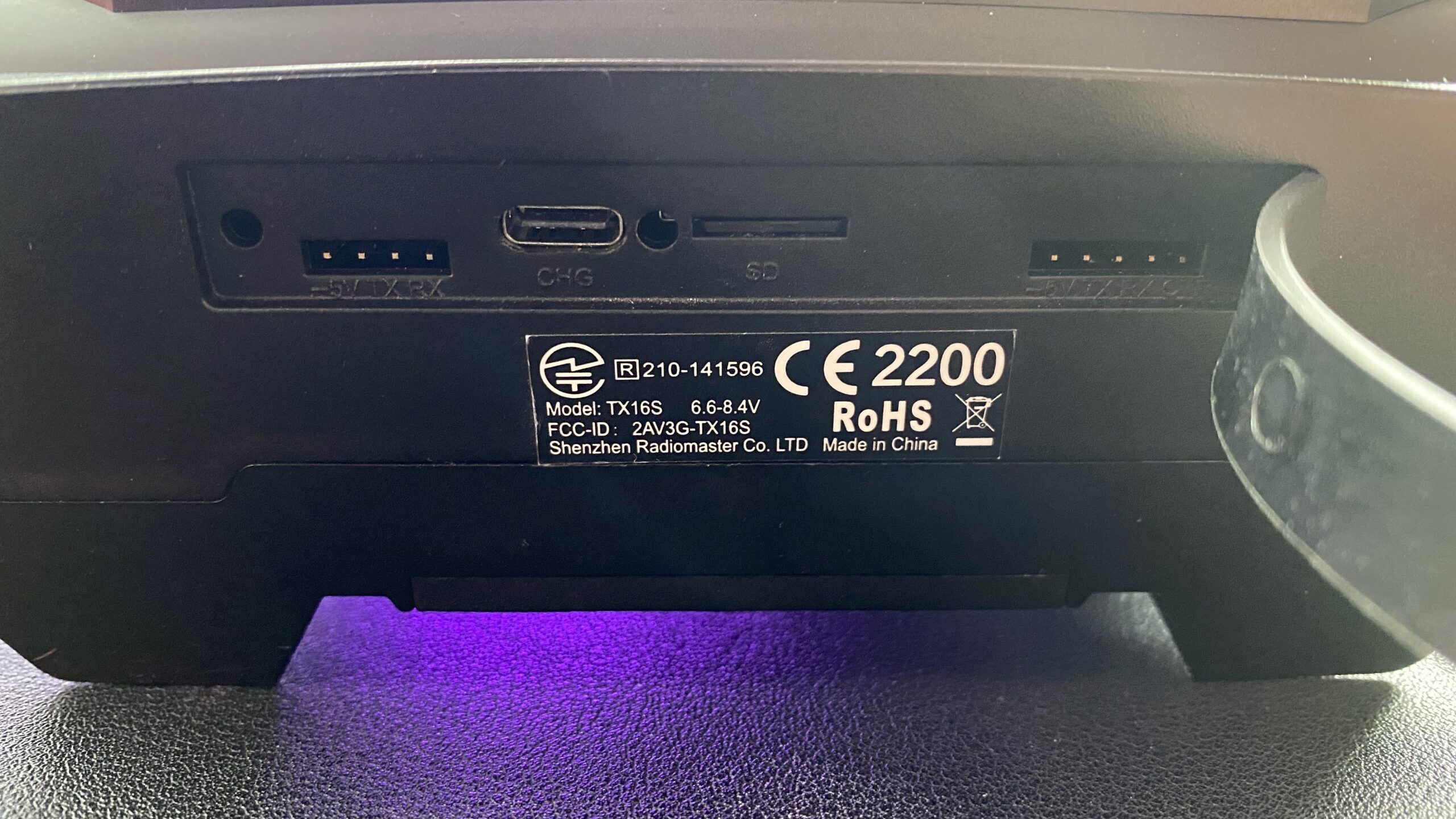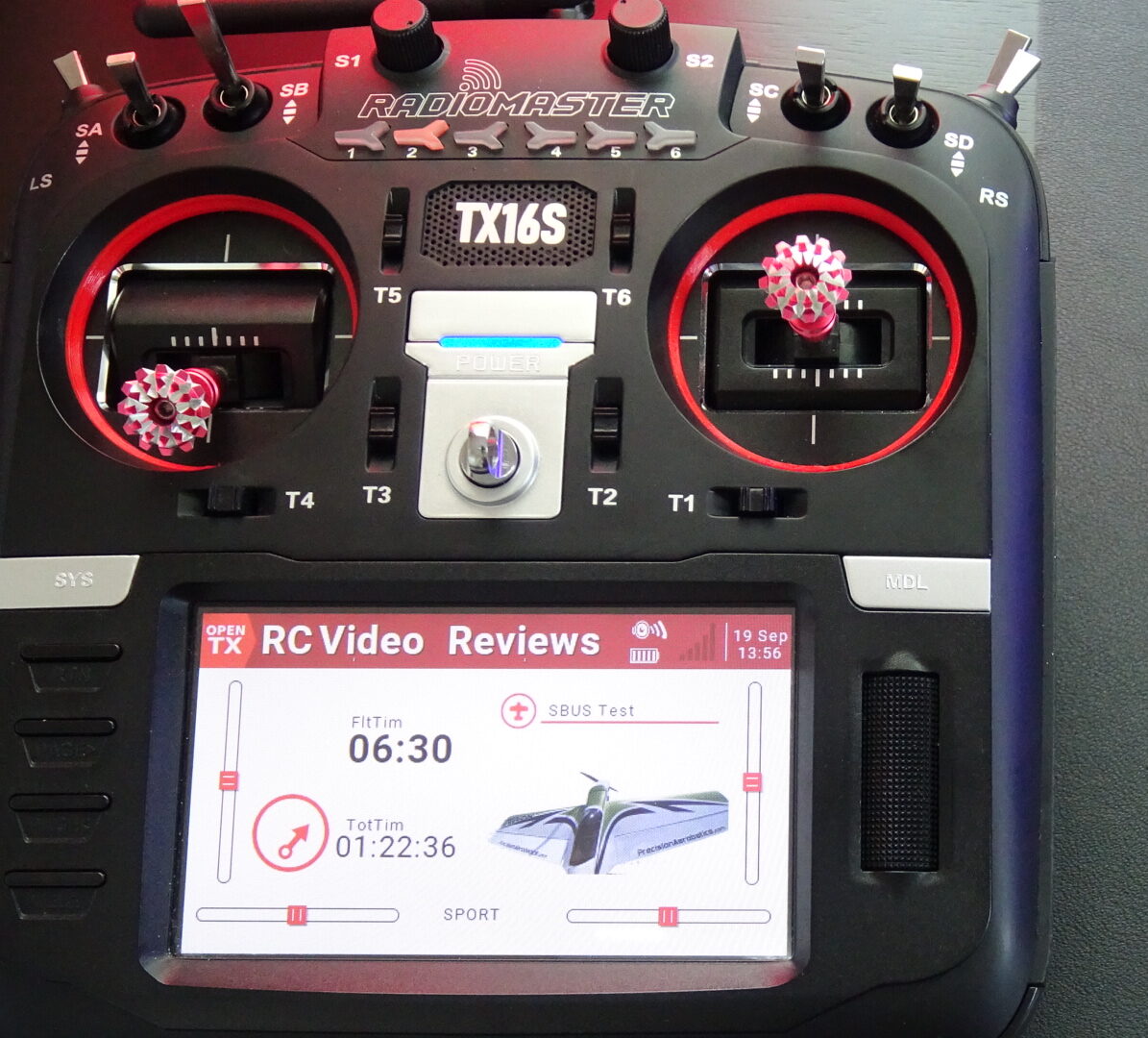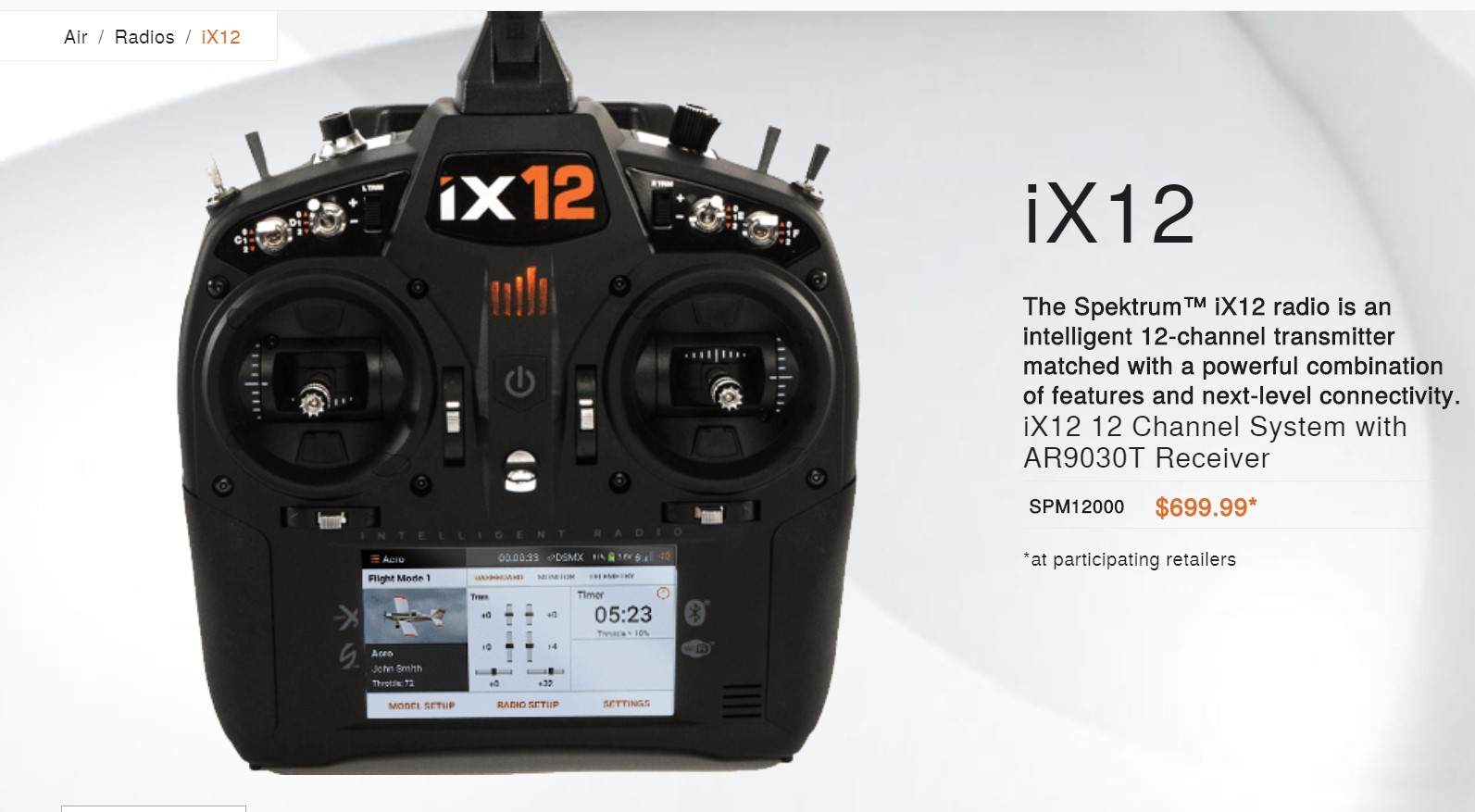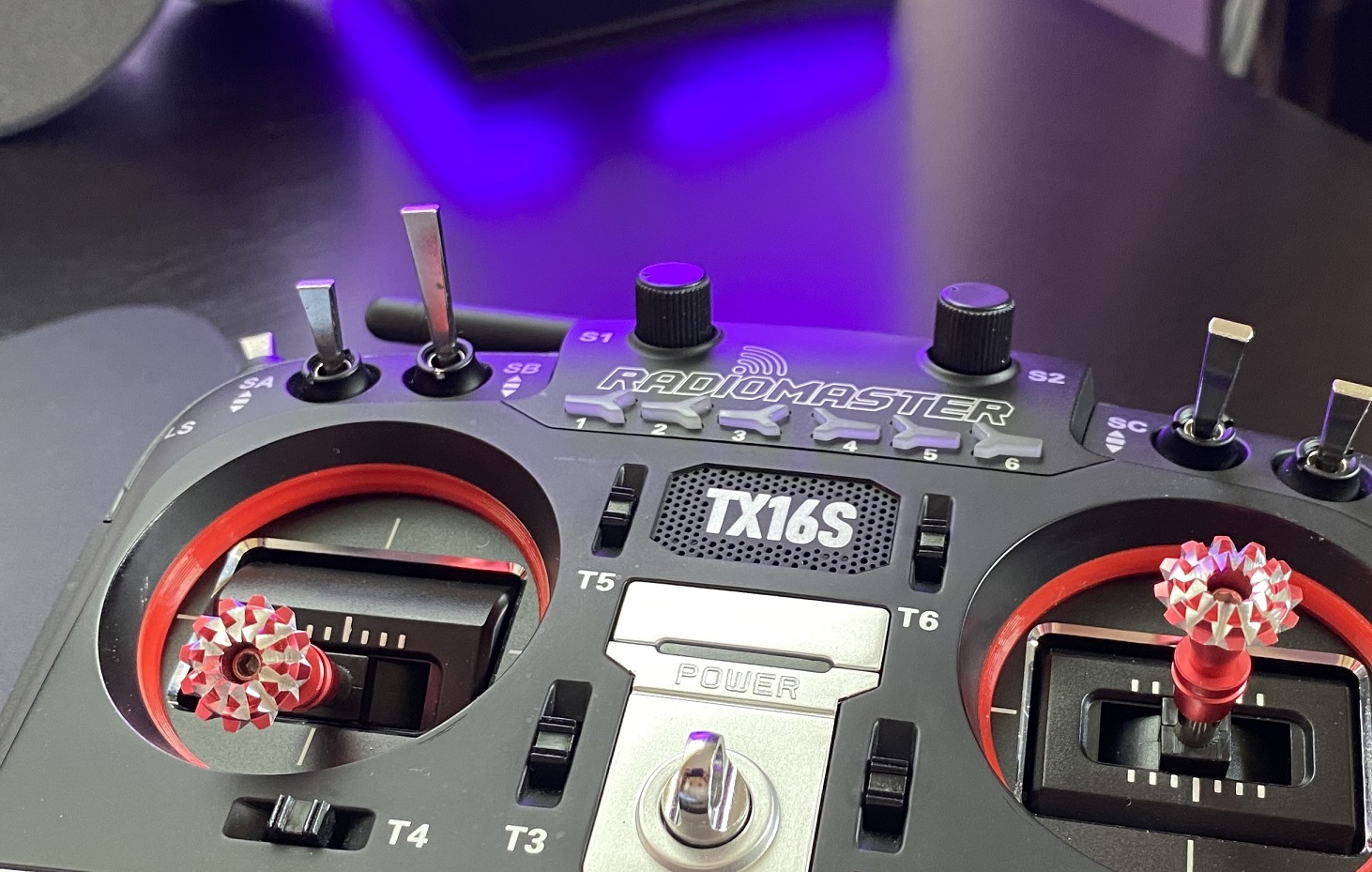Bottom Line Up Front
If you came here just to get the straight scoop: The Radiomaster TX16s is a solid radio with excellent usable features and easily takes over my daily flying needs from my beloved Taranis X9D Plus. So if you want to know whether or not you should buy one, my answer is a resounding yes. If you want to know more of my thoughts on this radio, keep reading.
Models and Pricing
The TX16s is packed with features and functionality allowing it to punch above its weight class. Retail pricing as of September 2020 hovers around $149 for the hall sensor/touch screen model which is definitely the one you want. You can add the TBS Micro TX v2 for another $70. Keep your eye out though. Retailers continually run sales and specials which might save you some money over suggested retail pricing.
Radiomaster TX16s Key Features
There is no shortage of technology packed into this radio. Rather than list every detail of the components, I’ll just list what I consider to be the standout features:
- Multiprotocol Module
- Hall Sensor Gimbals
- 4.3” Touch Screen Display
- Dual USB-C Ports: 1 Charger/1 Software
- External UART Ports
- Spare Internal Ports
- 6 Position Switch
The Multiprotocol Module [MPM] is the star of the show. In case you’ve been living under a rock and didn’t know about this, the MPM enables the Radiomaster TX16s to bind with most mainstream hobbygrade receivers—but not all. Notably absent are the more modern Futaba receivers and FrSky’s highly annoying ACCESS protocol. Futaba is so overpriced though, it’s no real loss. FrSky encrypted communications between their Tx and Rx so ACCESS is unlikely to ever be supported. All I can say is good riddance. The MPM can also bind with a huge list of other protocols found on various quadcopters using proprietary protocols.
Hall Sensor Gimbals use the hall effect to determine position of the sticks. The hall effect requires no mechanical linkage between the axis shaft and the sensor, so the widely held belief is that hall sensor accuracy will not deteriorate over time like mechanical potentiometers do.
Touch Screen Display units are generally reserved for much more expensive radios. As of this writing, the radio firmware doesn’t support touch; however, the 2.4.0 OpenTx firmware which will enable touch is under active development. While this isn’t a usable feature today, the hardware will be ready when the software catches up. Very advanced thinking on the part of Radiomaster.
Dual USB-C Ports provide awesome flexibility on the bench. One port is used for charging. It serves no other purpose. I give high marks to Radiomaster for not only including internal charging capabilities, but for using the USC-C interface. Their electrical designers “get the plot”. USB-C is the way forward and all of our devices should be using it. Radiomaster didn’t stop there though, they also added a USB-C port on the top of the radio to support connectivity to computers for things like radio backups, firmware updates, and access to the SD card. Perfect!
External UARTS are another forward-thinking hardware addition. Radiomaster added pins on the bottom of the radio near the USB-C charging jack and SD card slot. All three are protected by a rubberized dust cover.  I’m not aware of any equipment that can take advantage of these ports, but for DIY’ers, these ports are gold. Hopefully RC gadget manufacturers will produce some enticing goodies for those UART ports too.
I’m not aware of any equipment that can take advantage of these ports, but for DIY’ers, these ports are gold. Hopefully RC gadget manufacturers will produce some enticing goodies for those UART ports too.
Extra Internal Ports – Yet another scalable feature. Radiomaster anticipated that the 8 Switches, 2 Knobs, 2 Sliders, and 6 Twim Switches MIGHT NOT BE ENOUGH input options for some of you. So they included pads with the JST guides installed to accept two more switches and two more potentiometers. Who does that?
6 Position Switch FTW! Any article failing to mention the 6 position switch is doing a disservice to its readers. The Radiomaster TX16s includes a 6 position switch on the top of the radio. Those who utilize flight computers will instantly recognize the value of a single 6 position switch. If you’re not into flight computers, there are plenty of other ways to utilize this switch including setting up flight modes on OpenTx.
If you’re curious about flight modes and how to use the 6 position switch, I have a video on the RCVideoReviews YouTube channel showing you how to take advantage of both in OpenTx. FYI: OpenTx is the “firmware” the radio uses to interact with the hardware and it provides the graphical interface for configuring the radio.
Downsides to the Radiomaster TX16s
I wouldn’t be much of a reviewer if I didn’t find some things to gripe about some areas for improvement.
- Ratchet Mechanism
- Speaker Volume
- Stick Height
- Knob/Pots Feel and Centering
- Radio Thickness
The Throttle Ratchet Mechanism doesn’t work well. When I first opened the radio I noticed immediately the throttle ratchet mechanism did not ratchet enough for my taste–I just couldn’t feel the bump bump bump the way it felt on my Taranis. So I cracked open the radio and wrenched the spring down responsible for ratchet. Ok, no harm no foul. I noticed after a week or two of flying, the ratchet feedback had all but disappeared. I cracked the radio open again just to find out the spring tension wore the plastic ridges off responsible for creating the bump bump bump feel. There was no fix for this, so I swapped the gimbals and performed the necessary steps to convert the old throttle to a sprung stick and the new throttle to an un-sprung stick. I tightened the spring down just a tiny bit this time so I could get at least some feedback and a few weeks later–the ridges are gone on that one too. So they have some work to do on the ratchet mechanism.
Speaker Volume is too low on the radio I received. I found out later the Radiomaster TX16s had been updated and now ships with two speakers which changes the situation. The single speaker I received was serviceable. Fine for on the bench, but at the field with wind, people, planes, it really was just barely audible. The addition of a second speaker was required. Here is a video showing how to add one if you wound up with a single speaker version of the radio:
Stick Height is proud to say the least. For the average size adult male hand, I don’t believe the height of the stick is a deal breaker, but the sticks definitely do stand proud of the radio face. There have certainly been gripes on the forums about it. Some people have been disturbed enough to create 3D printed gimbal spacers. I told myself repeatedly “it doesn’t matter”, “it doesn’t matter”, “it doesn’t matter”…anyway, here’s my radio with the spacers installed.  If you don’t count the time to print, these spacers probably take under 30 minutes to install. You remove the back cover, remove four screws per gimbal, remove the beauty plate, install the spacer, install the beauty plate, replace the gimbal, repeat for the other side and button it up. It really is not difficult to do. Word of caution on the gimbal spacers though: Notice the aftermarket stick ends I have on my Radiomaster TX16s? They rub against the front faceplate when at full deflection down and in. The only fix is to raise the stick end which is counterproductive to installing the spacer in the first place. There is no issue with the stock stick ends–they just clear the face plate. On a sidebar, if you want those stick ends, Aloft Hobbies carries them. They use the same M4 stick ends as FrSky. The ends pictured are the Grand Lotus red stick ends.
If you don’t count the time to print, these spacers probably take under 30 minutes to install. You remove the back cover, remove four screws per gimbal, remove the beauty plate, install the spacer, install the beauty plate, replace the gimbal, repeat for the other side and button it up. It really is not difficult to do. Word of caution on the gimbal spacers though: Notice the aftermarket stick ends I have on my Radiomaster TX16s? They rub against the front faceplate when at full deflection down and in. The only fix is to raise the stick end which is counterproductive to installing the spacer in the first place. There is no issue with the stock stick ends–they just clear the face plate. On a sidebar, if you want those stick ends, Aloft Hobbies carries them. They use the same M4 stick ends as FrSky. The ends pictured are the Grand Lotus red stick ends.
Knobs and Sliders Potentiometers are not what they could be. Make no mistake, they’re serviceable and they do work. The biggest complaint out there seems to be with tension and centering. i.e. They move too easily and they don’t center well. It’s hard to argue with that reasoning after coming from the Taranis which–in retrospect–has killer pots and gimbals. I decided I needed to see if alternative pots would make a big difference, so I did a video showing how to swap the slider pots and posted it to the channel:
You should watch that video to see how things turned out.
Radio Thickness – I’m only including this for completeness as this is another common complaint about the Radiomaster TX16s is how thick it is around the sides and back. Personally, I have no problem with this thickness, but I do empathize with people who may have smaller hands than the average adult male. It is easy to see their point of view when this radio is compared to others. Unfortunately there is no known fix for this as the rubber grips in the back cover ridge in the plastic molding. I supposed with a hot knife, epoxy, and vacuum forming equipment one might be able to affect a change. Otherwise, you’re stuck with it.
Personally, I have no problem with this thickness, but I do empathize with people who may have smaller hands than the average adult male. It is easy to see their point of view when this radio is compared to others. Unfortunately there is no known fix for this as the rubber grips in the back cover ridge in the plastic molding. I supposed with a hot knife, epoxy, and vacuum forming equipment one might be able to affect a change. Otherwise, you’re stuck with it.
The Competition? What Competition?
This radio costs a fraction of comparable name brand radios. Seriously – 16 channels with a single module, 32 with an external module. That alone destroys the competition. You’ll be into Spektrum for $700 for 75% of that channel count.
Or $1399 to buy the Spektrum iX20 with 4 more channels than the TX16s.
You don’t even want to get me started on the receiver costs. If you want a genuine Spektrum receiver, you’re looking at $70 FREAKING DOLLARS for a 6 channel receiver with telemetry. That’s no stabilization by the way–just 6 channels. With telemetry. For $70 FREAKING DOLLARS. No thanks.
I suppose if all you’ve ever used is Spektrum and you have money to burn, then Spektrum is a good choice. I can’t help but laugh though when I hear guys at the field negotiating to the last penny for a used plane, or a used motor, but they’ll shell out $700 for a radio and $70 for a receiver that both have a fraction of the capabilities of the Radiomaster TX16s.
Before some wise guy comes in and starts going on about Spektrum wireless technology–you better go do your homework first and realize you absolutely have the low ground on this argument.
- Radiomaster TX16s supports DSM, and DSMX. So case closed.
- Radiomaster TX16s supports FlySky, FrSky, ErSky, Futaba, HiTec, and a handful of other mainstream protocols along with a boatload of drone/quad protocols.
So the Multiprotocol module can use the most modern Spektrum protocol implementation plus damn near everybody else’s. Here’s the list if you like your eyes to bleed. Here are a couple of videos showing the TX16s binding with FlySkt and DSM protocols:
Final Thoughts
Using the 5000mah LION Radiomaster battery, this radio lasts for days between recharges. The onboard charger has been flawless and connectivity to the PC works perfectly as well.
The ergonomics do take some getting used to. The body is thicker and the sticks stand taller than other radios including the Taranis and the Jumper T18. For me, the ergonomics are not a deal breaker. If you have smaller hands, or if you are particular about ergonomics, I would strongly advise you to try and put your hands on one before shelling out the cabbage to buy one.
Everybody always want to know how the sticks feel. My response is that ball bearing gimbals will not be discernable radio to radio. It’s the centering and spring tension that make up the feel. I did replace my springs with Futaba Heavy Duty springs because I prefer stronger resistance. This is absolutely not commentary on the stock springs–they’re fine.
With my speaker upgrade and the very bright LCD screen, I have no problems utilizing this radio outdoors in direct sunlight, and I live in Florida, so I’ve had ample opportunity to evaluate screen visibility outside.
The biggest disappointment I can muster about the radio are the pots. I hope Radiomaster finds a better option for the next release. But this is a ridiculously easy part to change and while not ideal, they are functional, so therefore are not a deal breaker for me.
The Radiomaster TX16s costs $150 dollars. It has 16 channels internal + 16 more external. FYI The external mod is $40 at Amazon. So where Spektrum charges a mere $700 to add 8 channels, you can easily double the Radiomaster TX16s from 16 to 32 for $40. You’re welcome.
Regarding Receivers: FlySky ia68 is $17.00 at Amazon or $11.00 at Value Hobby if you can wait a few days to get it–and yeah, it has telemetry. Lemon receivers are $16 at Altitude Hobbies. No telemetry on these though.
From a hardware cost vs benefit standpoint, I have no idea why anybody would buy Spektrum and I haven’t even touched on the software capabilities OpenTx provides for the Radiomaster TX16s.
How about that: I just realized how apropos the brand name Radiomaster actually is.





Excellent write up! Love mine so far. Since you’re in Florida, have you noticed any issue as the tx warns losing calibration? I believe it’s called thermal drift and can affect HALL gimbals. I haven’t had this on mine but ran across it on a forum. For the $ it blows Spektrum out of the water and with your videos on OpenTX to help with the learning curve there’s no reason to not get one.
*warms